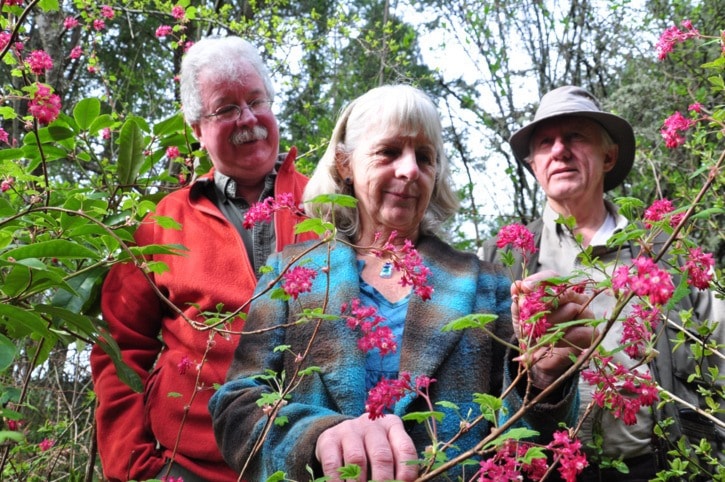With sturdy hiking boots and clipboards in hand, people who know their flora from their fauna are preparing to fan across beaches, forests and wild spaces of Metchosin for a census, of sorts.
They plan to count everything – every plant, fungi, lichen, insect, bird and hoofed animal. Everything that grows, moves or has a pulse. It’s an ambitious undertaking and aptly named the Metchosin “BioBlitz,” and it's due to launch on April 30.
The event organizers aim to inventory as many living things as possible within 24 hours, and provide a biodiversity baseline for future blitzes. But it’s also meant to educate the public and drive home the notion that people share the local landscape with thousands of plants and animals, some rare, some endangered.
“We want the people of Metchosin to realize where they live and how special it is. We’ve got some of the rarest habitats in Canada – coastal Douglas firs, Garry oaks exist here,” says Metchosin Coun. Moralea Milne. “There is very little Garry oak ecosystems left. There’s no room to lose anymore.”
Milne and fellow Metchosin residents Kem Luther, and Andy MacKinnon, a research ecologist with the B.C. Forestry Service, have rounded up more than 50 plant and animal experts for the blitz – taxonomists who know the difference between a pteridium aquilinum (bracken fern) and a polystichum munitum (swordfern), and a sciurus griseus (grey squirrel) from a tamiasciurus hudsonicus (red squirrel).
“In Victoria you don’t have to go far afield to get the best (experts) in the province. A lot live on south Vancouver Island,” MacKinnon says. “We’ve got a lot of provincial experts, some from (the University of Victoria), and a number of very skilled amateur naturalists.”
It’s impractical for the BioBlitzers to cover the 71 square kilometres that make up Metchosin in one day or even a few days, so they’ve selected specific areas flush with life and accessible to the public.
BioBlitzers will survey parks such as Devonian, Witty’s Lagoon and Matheson Lake. Birders are heading out at dawn to prime bird-watching vantage points, and owlers will prowl the forests after dark.
Some ecologists will strike out on small, non-public expeditions, where large groups would frighten animals or likely trample plant life. Members of the South Vancouver Island Mycological Society, for one, will have their noses to the ground in search for fungi.
“We need to watch where we send large numbers of people,” says Milne, who has surveyed Metchosin plants and butterflies in the past. “We want people to go to places that can handle a crowd.”
“It’s a great free community event,” MacKinnon adds. “Experts love being out working with kids and families. Kids get to go out with people genuinely fascinated by things like slugs.”
“It’s science, education and entertainment,” remarks Luther, who is a keen amateur expert in fungi and mosses.
The concept of a BioBlitz came out of the U.S. National Park Service in the mid-1990s and have been conducted across the U.S., the U.K., Australia and New Zealand. Beacon Hill Park in Victoria underwent the region’s last BioBlitz in 2007.
Marilyn Fuchs, a biologist with CRD parks, says BioBlitzes in Whistler have discovered previously unknown species of plants and insects.
“It’s a good way to get people inspired about biodiversity and learn how diverse habitats can be,” Fuchs says. “For (CRD) parks it dovetails with our mission, it’s good to see people get excited about the natural world.”
Milne, MacKinnon and Luther hatched Metchosin’s BioBlitz after conducting more than 40 free “walk and talk” community events, where an environmental expert would speak on a topic on a Friday night, and then lead a related trek in the wilderness on Saturday morning.
“The time is right to do a BioBlitz. We’ve been doing the walk-and-talk for so long, we thought we needed something else to educate the public,” says Milne, the originator of the walk-and talk-program.
“Kids need to learn that adults get paid to go and play like this,” MacKinnon says laughing, “and that mosses and fungi are cool.”
The Capital Regional District, the District of Metchosin and the Metchosin Foundation are sponsoring the BioBlitz, which will allow organizers to give “swag bags” to the volunteer experts. The lists of plant and animal species found in Metchosin will be published on the website about a month after the blitz.
The Metchosin BioBlitz is April 30, and based out of the Metchosin Community House, 4430 Happy Valley Rd. See metchosinbiodiversity.com for the schedule of public expeditions and for more information.
Groups are scheduled to leave at 6 a.m. (birders), 9 a.m., 2 p.m. and 9 p.m. (owlers). A talk at the Metchosin municipal hall is scheduled for 7 p.m.
editor@goldstreamgazette.com
